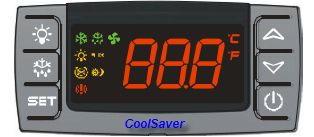The CoolSaverTM Marine Refrigeration Controller 
More than a thermostat or speed controller
A modern, cost effective digital controller that minimizes battery energy requirements for marine refrigeration systems.
-
Minimizes battery energy consumption and controls temperature accurately.
-
Cost effective.
-
Easy to install.
-
Suitable for any refrigeration system that uses Danfoss BD35F, BD50F or BD80F compressors with either holding plates or evaporators, and air or water cooled condensers. (Dometic-Adler Barbour, Isotherm, Nova Kool, and others).
-
Does not require, but enhances Danfoss AEO (Adaptive Energy Optimizing) compressor controller.
-
Charge SenseTM technology detects available excess power. It saves energy by automatically taking advantage of excess available power from any source; alternator, generator, wind generator and solar power.
-
Displays temperatures in Fahrenheit or Centigrade and has a full set of status indicators.
-
Records lowest and highest temperature. Has manual reset.
-
Temperature alarms with buzzer, and programmable shutdown on high condenser temperature.
-
Continued refrigeration if thermistor probe fails.
-
Warm food load feature.
-
Energy Saving Mode.
-
Fully configurable from the front panel.
-
Low space requirement: 1.14” x 2.8” (29x71mm) panel cutout.
-
Manual and programmable automatic defrosting.
-
Uses sealed stainless steel solid state thermistor probes.
-
Front panel is IP65 water protected. Conformal coating on electronics protects against the marine environment.
CoolSaver was designed by BostonBase Inc.- a software and controls company that since 2003 has been developing control solutions for refrigeration with an emphasis on energy savings.
Options
|
|
Last Updated on Monday, 20 September 2010 12:09 |